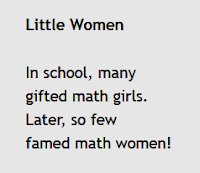German mathematician Karl Friedrich Gauss (1777-1855) is one of history's most prolific and influential mathematicians -- and he is interestingly described in the following acrostic poem.
K arl Friedrich Gauss by Stuart J, Silverman
A puzzle, that his brash genius often shrank,
R eluctant to publish? Hardly. The fact is he
L ingered, perfecting this or that theory
F orged in the heat of his private think tank.
R eworked his proofs until some thought they stank.
I nside and out, of misplaced purity.
E ntered the ages, one of a company
D ecidedly small -- not its only crank.
R ancor and jealousy, admittedly touched him,
I mpelled the pettish note to Bolyai,
C ruelly sent, perhaps on a whim,
H ead and heart each going its separate way.
G ranted the meanness, vanity, display,
A ll such human failings, what he worked would change
U nder his hand to the gold of a new day.
S ettled into its fame, his thought would range
S ecurely through the numinous and strange.
This poem by Silverman is on my shelf in the collection Against Infinity: An Anthology of Contemporary Mathematical Poetry, edited by Ernest Robson and Jet Wimp (Primary Press, 1979). This collection is out of print but copies may be located here at bookfinder.com.
What are the COSTS of GENIUS?








